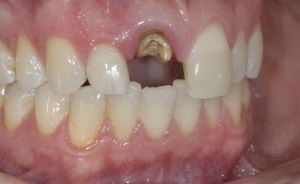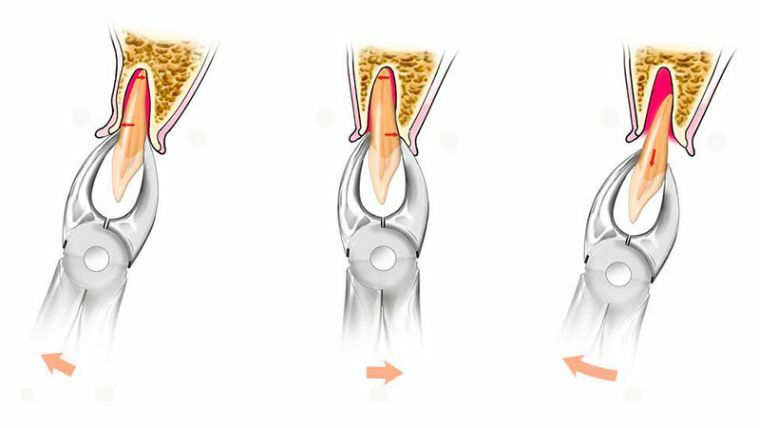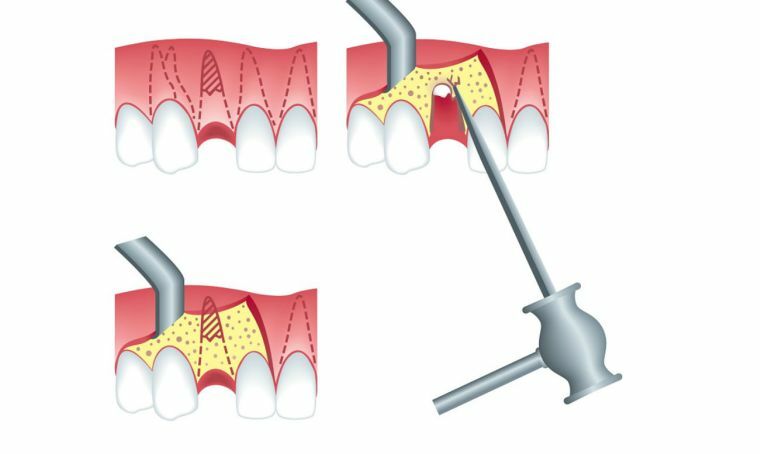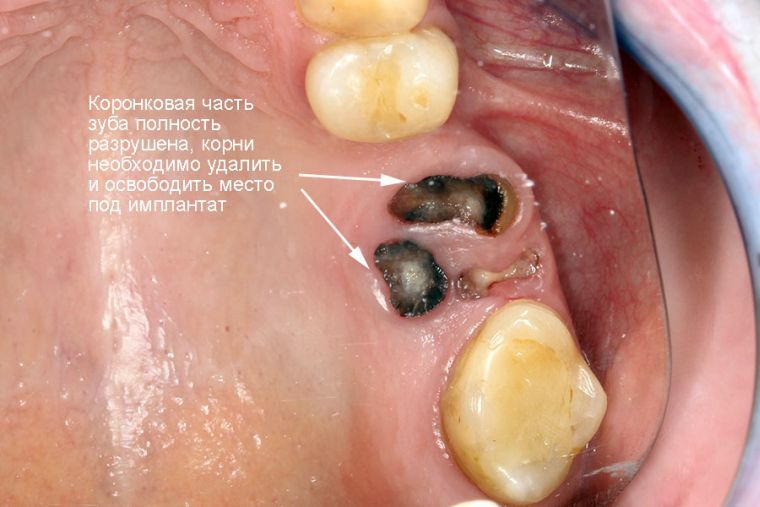 Visiting a dental clinic for many people is a test, especially when it comes to removing the roots of the tooth.
Visiting a dental clinic for many people is a test, especially when it comes to removing the roots of the tooth.
Modern medicine allows you to produce this procedure without pain, discomfort and complications.
Contents of
- In what situations is operation required
- Small spine, yes removed
- Preparing for operation
- What tools are used?
- Removal methods - their three basic
- Special cases
In what situations is operation necessary
To save dental health is the main task for a person, but there are situations when removal is inevitable.
It is not uncommon for teeth to break down, fall out, and the root remains inside the gum - this is the main indication for its removal. Leave the root if the tooth is destroyed dangerously, since in time the inflammation may start, pus may appear.
The presence of the root can be determined by the following symptoms:
- aching pain in the gums with "twitching" in place of the dropped or removed tooth;
- characteristic severe pain with mechanical action( pressure during eating);
- soft tissue gum disease;
- redness, bleeding, inflammation;
- suppuration and fever.
The root must be removed as soon as one of the listed symptoms has manifested itself. To postpone visiting a dentist is impossible, as this can lead to serious consequences, up to the infection of blood.
Small root, yes removal
Removing the root of the tooth is a surgical procedure that must be performed only by a specialist. The complexity of the operation is determined by several factors: 
- tooth size;
- the state of the tissues around it;
- with gum defects( if any);
- placement inside the gums.
It is also important to take into account contraindications, as they influence the choice of the removal technique.
The main contraindications are:
- ARI and ARVI;
- mental disorders in the phase of exacerbation;
- of CNS disease;
- recovery period after hypertension or heart attack.
In some cases, according to the doctor's testimony, root removal is performed in a hospital setting.
In most cases, the dentist will offer anesthesia, although the process of removing a completely destroyed tooth, in which only the root remains, will practically not bring negative sensations - this is also a feature of the operation.
Difficulties during the operation can occur if the root is removed after the crown is broken or the root is deep in the hole.
Also known as pulling out curved and thickened roots. In other cases, the work of the dentist in this direction is considered easy.
Preparation for operation
 Preparation for the operation is carried out according to the general scheme: examination of the oral cavity and directly the zone, which requires special attention of the dentist.
Preparation for the operation is carried out according to the general scheme: examination of the oral cavity and directly the zone, which requires special attention of the dentist.
At this stage, the choice of the method of anesthesia is made - it must take into account the age features, the presence / absence of diseases, the characteristics of the organism, for example, allergies to medications.
Also at this time, the doctor who will perform the intervention, makes the selection of the necessary tool.
Immediately before the operation, the dentist performs an examination of the gum tissue to determine if there are inflammation or suppuration.
The information obtained during the survey makes it possible to draw up a detailed plan for future work. The operation is performed by a doctor in gloves and a mask.
After this comes the turn of the hygienic treatment of the oral cavity, in order to prevent bacteria from entering the wound.
Sometimes, before proceeding to remove the root, the doctor must first remove plaque or stone from the teeth that are near the site of the operation.
If there is a difficult removal, then an additional stage of hygienic treatment is the treatment of the facial skin with alcohol, as well as a solution of Chlorhexidine bigluconate.
After that, a sterile towel or a special cloak should be placed on the patient's chest to avoid contaminating clothing.
Anesthesia is part of the preparation when removing the roots of the teeth. Drugs should be selected carefully, taking into account the state of human health. Sometimes it is necessary to pre-cut the gums, especially if the root is deep in the hole or it is not visible during visual inspection.
What tools are used?
The following types of instruments are used for the operation: 
- syringes;
- elevators of various types;
- drill.
Based on what tools will be selected for the operation, certain methods of work are selected.
For successful procedure, it is necessary to exfoliate the circular ligament of the tooth or syndesmotomy. It is conducted regardless of the chosen methodology. In addition, the choice of method depends on where the removal is required.
Then one of the following methods is used:
- A root extract with forceps on the upper jaw is performed using the tool with the straight ends of the .If you want to remove the roots of molars, then bayonet-shaped wide forceps or as they are called universal, because they are used to extract roots anywhere on the upper jaw.
- The rotation technique of or rotation should be used if the operation involves the removal of the root of a single-root tooth, or if the roots of the multi-rooted teeth are located separately. In the event that the roots are connected, they must be dislocated.
- On the lower jaw, the root removal method is also successfully applied. In most cases, use beak-shaped forceps. The removal procedure is similar to the removal of the roots of the upper jaw.
- Removing tooth roots with elevators is another widely used technique in dentistry. She also suggests that at the first stage of the operation, a syndesmotomy will be performed. Then the working part of the elevator is gently inserted between the root of the tooth and the wall of the alveolus of the gum and carry out all the necessary actions aimed at removing the root. In the case where it is necessary to perform dislocation, the elevator is used as a lever.

On the photo removal of the root of the tooth with the
forceps Methods of removal - their three basic
Modern dentistry conducts several types of operations to extract the roots of the teeth.
So, with the use of what techniques are removed the roots of teeth modern dentists:
- Hemisection or partial extraction of the tooth and root. It is carried out in most cases on molars located on the lower jaw. The technique allows to completely exclude the development of pathological processes. The affected root is to be removed with the crown attached to it or the upper part of the tooth. After that, the teeth and roots that are located near the root to be removed are sealed.
- Amputation of or complete root removal. This technique is used when it is necessary to perform an operation on the upper jaw. First, it is required to bare completely the roots of the teeth, if they are poorly visible or located deep inside the jaw. This means that the doctor sprays the mucous tissues on the gum. After this, the root is cut off with a drill and is removed from the socket using universal forceps. At the final stage, the space is filled with a special medical composition - osteoplastic material.
- Cystectomy or removal of the cyst formed on the root of the tooth. The operation is as follows: it is necessary to strip the top part of the root, then to reveal the cyst and remove it. In the end, the doctor fills the formed space and surrounding tissues with osteoplastic material.

Root amputation
Removal of the root of the tooth and subsequent suturing of the wells - visual video:
Modern root removal methods are performed under local anesthesia. Sometimes there is special treatment of teeth under general anesthesia, but this is done only in a hospital and if a person undergoes a course of treatment for the underlying disease.
Therefore, the operation is painless for the patient.
Special cases
Sometimes expression of roots takes place in unusual conditions.
Special cases are called:
- removal of the root of wisdom tooth;
- root extraction in case the tooth is destroyed;
- presence of gum disease, for example, periodontitis.
Also to the special situations include the presence of serious diseases, for example, diabetes or epilepsy, when it is highly not recommended to use some types of anesthesia.

In addition, it can take children up to 12 years to remove roots, in which case the operation also takes place in an unusual mode.
Thus, extracting the root is a painless operation that does not take a long time and does not require a long recovery after it. A variety of techniques will allow you to make dental surgery with all the characteristics of the body, so do not postpone your visit to the doctor.
